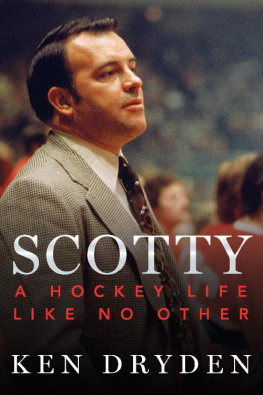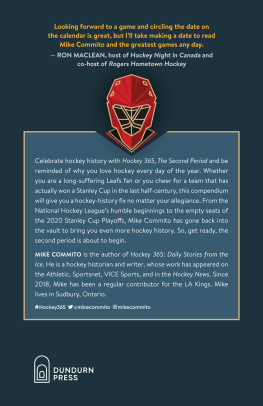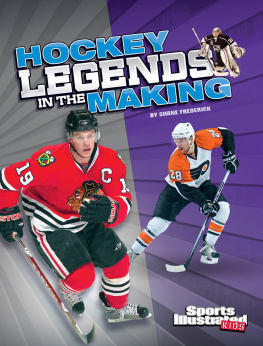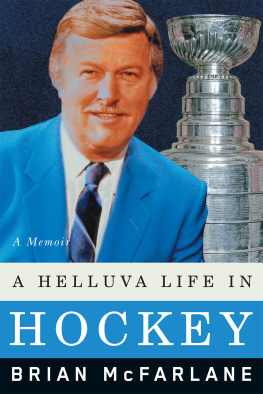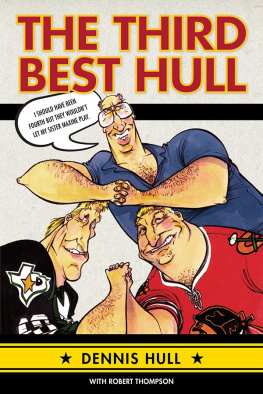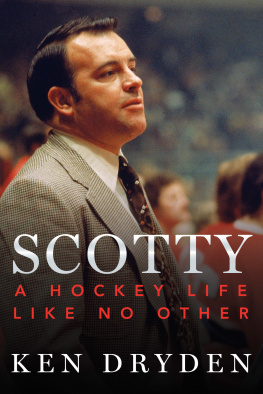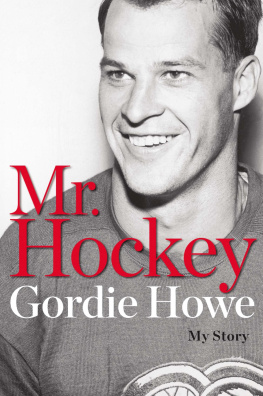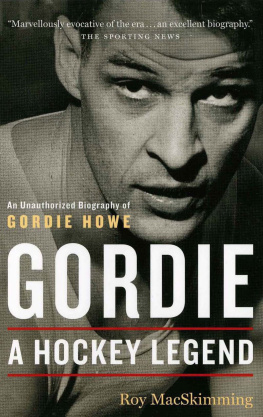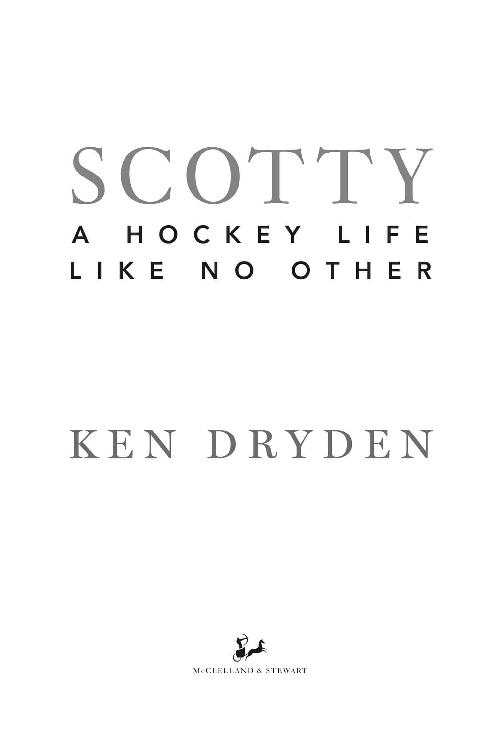BY THE SAME AUTHOR
Game Change: The Life and Death of Steve Montador and the Future of Hockey (2017)
Becoming Canada: Our Story, Our Politics, Our Future (2010)
In School: Our Kids, Our Teachers, Our Classrooms (1995)
The Moved and the Shaken: The Story of One Mans Life (1993)
Home Game: Hockey and Life in Canada with Roy MacGregor (1989)
The Game (1983)
Copyright 2019 by Ken Dryden
McClelland & Stewart and colophon are registered trademarks of Penguin Random House Canada Limited.
All rights reserved. The use of any part of this publication reproduced, transmitted in any form or by any means, electronic, mechanical, photocopying, recording, or otherwise, or stored in a retrieval system, without the prior written consent of the publisheror, in case of photocopying or other reprographic copying, a licence from the Canadian Copyright Licensing Agencyis an infringement of the copyright law.
Library and Archives Canada Cataloguing in Publication data is available upon request
ISBN:9780771027505
Ebook ISBN:9780771027512
Fifty Mission Cap (Johnny Fay, Gordon Downie, Robert Baker, Gordon Sinclair, Paul Langlois). Copyright 1992 by Little Smoke Music/Southern Music Pub. Co. Canada Ltd. Copyright Renewed.
International Rights Secured. Used by Permission. All Rights Reserved.
Book design by Jennifer Lum
On the cover: Canadian hockey coach Scotty Bowman of the Montreal Canadiens, dressed in a suit, watches the action from behind the bench, 1970s. Bruce Bennett Studios/Getty Images
McClelland & Stewart,
a division of Penguin Random House Canada Limited,
a Penguin Random House Company
www.penguinrandomhouse.ca
v5.3.2
a
Contents
For Sofie (8 months), Dorian, Emmy, Lilliana, Ryan, Graycen, Tyler, Cam, Lindsey, Will, and Ashley (20 years)
AUTHORS NOTE
This is the fourth book I have written about hockey. One, I wanted to write. Three of them, including this one, I needed to write.
I wanted to write Home Game (with Roy MacGregor). I thought that for a reader who knows about hockey, it would tell them a lot about Canada; and for someone who knows about Canada, it would help them to understand hockey. It was the approach Ken Burns used a few years later in his TV series about baseball.
I needed to write The Game. It was my first bookand, I felt certain at the time, it would be my only book. I had lived a life fully immersed in hockey, from ball hockey games in our backyard in Etobicoke, Ontario, to the Montreal Forum, to the Luzhniki Ice Palace in Moscow. It was a life that had left me with little time to think or feel. I wanted to stop the rush, to try to make sense of it for myself, and to put it down in words for others. And to do it myself, with no ghostwriter to ease my way and shield me from the test of uncovering my own story.
I needed to write Game Change: The Life and Death of Steve Montador and the Future of Hockey. Before I was a player, I was fanand now Im still a fan, and a grandfather of kids who play. I thought the mountain of awareness about brain injuries and science was too scattered and too easy to dismiss, and was taking us nowhere. I thought the only way to truly understand the dimensions of the problem was through a person. A life. Steve Montadors life. For us to know the stakesunmissably, undeniablyin order to generate the will needed to take the decisions that will make hockey just as exciting to play and watch, but less dangerous, for everybodys kids and grandkids. And, most crucially, I thought the only way to inspire this change was to set out how to do it.
I needed to write this book for very different reasons. Scotty and I shared a time togetherthe most important of my hockey life, and one that surely matters to him too. But more than that, Scotty has lived a truly unique life. He has experienced almost everything in hockey, up close, for the best part of a centuryand his is a life that no one else will live again. Its a life that had to be captured. And it needs to be captured now, because time is moving on. We are both in good health, but we are also at an age when things can intervene. I had thought of writing this book for almost 10 years, and I was sure I would never get to it. I also thought someone would save me the obligation and do it first. But no one did. So on March 26, 2015, at 10:44 a.m., I wrote Scotty an email that said simply, There is something Id like to talk to you about.
Six minutes later, at 10:50 a.m., he replied: For sure.
This is the result.
CHAPTER ONE
Robbie Irons was one of more than a thousand players Scotty Bowman coached during his career. He played three minutes and one second of one game for the St. Louis Blues during the 196869 NHL season.
I had played with Robbie for the Junior B Etobicoke Indians four years earlier. He was the teams backup goalie. Later, I went to Cornell University, while Robbie played one more year with Etobicoke, then one season with the Kitchener Rangers in the Ontario Hockey Association (later the Ontario Hockey League).
It was a Saturday night in Ithaca, New York, when I sat down to watch the Rangers play the Blues on WPIX. The NHL had expanded from six teams to twelve the year before, and the Original Six franchises had made few NHL-calibre players available in the expansion draft. The new teamsSt. Louis includedhad needed to be creative. Players that were dismissed in earlier years as too old or too small or too soft, or even as college guys, or Americans, had to be given another look.
Jacques Plante, at age 39, had last played in the NHL three years earlier, having retired after two disastrous seasons with the Rangers. Glenn Hall was 37. The Blues decided that even if Hall and Plante were too old to be the dominant goalies they had once been when playing nearly all of their teams games, they might have enough left as a tandem, each playing about half the time. To save them from any unnecessary wear and tear, St. Louis decided to keep a third goalkeeper on their roster as wellto dress as the backup so Plante or Hall got the night off when the other one played. The Blues rotated three young goalies in this role, and one was Robbie Irons.
Hall was in net that night in New York. The Rangers scored almost right away. Hall, believing that the goal should have been disallowed, argued with the referee and was given a misconduct penalty. Now even angrier, he kept arguing and was thrown out of the game. Immediately, Scotty and Robbie realized the same thing. Robbie was going to need to play.
This much of the story I knew: that Robbie did play, and that a few minutes later he was replaced by Plante. I remember thinking that here was Robbie Irons, my backup with the Etobicoke Indians, playing in a real-life NHL game. But the rest of the story, I didnt know until not long ago.
Robbie, stunned and still disbelieving when Hall was ejected, stayed seated on the players bench. Scotty, not quite willing to accept his predicament, finally got word to Plante to get down from the press box and dress as fast as he could. Scotty then nodded to Robbie, who skated slowly to the Blues net. At this moment, Doug Harvey, on the ice, sauntered over to the boards and stood next to Scotty. Harvey was 43 years old and had played only 16 NHL regular-season games in the previous five seasons. The most dominant defenceman of the 1950s, unconquerably hardened and tough, he mumbled to Scotty, We dont want him to play, do we?

